GlassPhone (Museum)
, Dresden

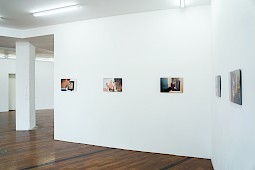
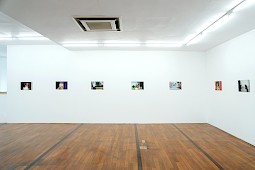
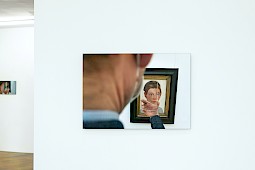
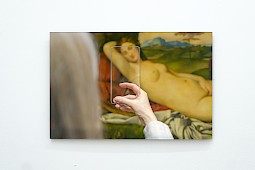
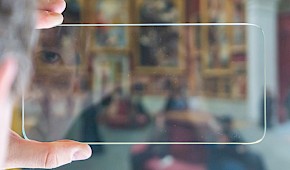
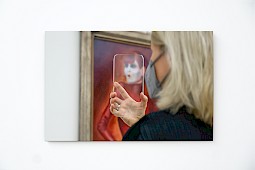
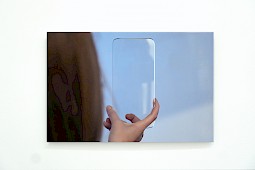
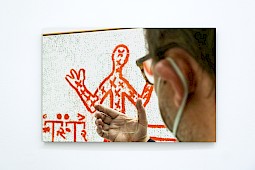
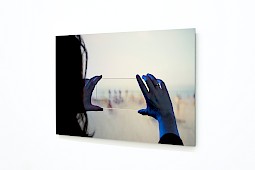

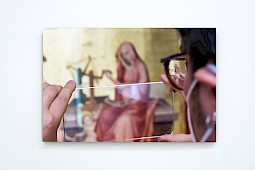
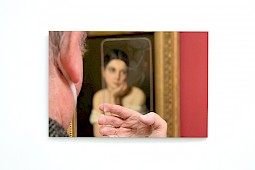
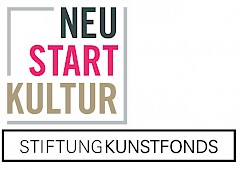
Seeing_Through_Looking_Through_Gazing: Tilman Hornig’s Alienation Strategy
by Bernhard Maaz
Photography reproduces the seen and the given: that is the straightforward, commonly-held opinion. As is well-known, however, it has long been possible to manipulate photographic images if they are to serve journalistic, political or perhaps also ideological interests. By now, there are software programmes in existence that enable even any private individual to erase from his or her holiday photos–and thus from materially manifested memory–persons who have dropped out or been cast out of their lives, or deliberately forgotten. And the respective advertising wipes the former partner off the screen, making possible, as it were, autobiographically retrospective image manipulations that extinguish elements of a curriculum vitae and hence of life experience. Consequently, photography has long become manipulable for everyone and anyone on an absolutely day-to-day basis. It thus needs to acquire a new methodology for the establishment of truth and new strategies of assertion–both for the medium’s own self-assertion and for asserting the truth of what is depicted.
Born in Zittau in 1979, Tilman Hornig studied in Dresden under Martin Honert and others. He currently lives and works in Dresden, employing a variety of artistic media, among them photography. Most of the photographic images that mankind generates and consumes nowadays are not viewed in albums or in exhibitions but on the so-called mobile device or terminal, the smartphone or, at the outside, the laptop. The ground-glass screens of the erstwhile tube-based devices–the television sets–have been superseded by the backlit glass pane of the display. The fact that these glass surfaces have often become the “creatures” with which human beings have the most skin contact day-in, day-out is one of the bizarre features of the technological alienation of human beings from one another and from Nature. In passing, it is worth noting the fact that precisely this pane of glass is the most often damaged component of the robust technology and one which hence embodies the fragility of seeing. The instrument of seeing on the device is just as vulnerable as the retina of the human being.
In his series “Glass Phones”, Tilman Hornig isolates precisely this rectangular piece of glass with its characteristically rounded corners and its gently ground perimeter edge. He separates the optical aid from the device and allows us to see it, makes us see through intense gazing, makes the act of looking-through vividly visible, and combines seeing as looking-at with gazing as seeing-through. In a comparable way almost half a century ago, Nam June Paik concerned himself with contemplative seeing and the visualization of the act of seeing in his work “TV Rodin (Le Penseur)”: the screen of a small television set shows the picture that an adjacent camera records of a small-format replica of Auguste Rodin’s “Le Penseur”. The motionlessly sitting thinker thinks, the camera films, the screen displays, the beholders see the self-enclosed circuit of image (re)production, see an icon of sculpture becoming an iconic image by means of technological aids and, there again, see the entire ensemble becoming a self-referential icon of the viewing of art.
So what could be more appropriate for an artist of today than to reassure himself concerning the seeing of art by means of a, so to say, deaf-dumb-and-blind instrument–the “glass phone”–and with the assistance of professional art scrutinizers, i.e. with the directors of museums of art or ethnology or with members of their teams. Tilman Hornig travels the country with his camera and the almost sculpturally isolated glass pane on the look-out for people who are willing to become involved in his project. He does and did this independently of many other digital projects that are taking place up and down the land. Nevertheless there are chance affinities, as for example in the recent past with the advertising campaign for an exhibition project in the Städtische Galerie Villingen-Schwenningen, which reflects the current developments under the slightly provocative title “Digital is Better”–a reference to a song that the band Tocotronic brought out in 1995. Is digital better, or is this a euphemism? The advertising campaign for the project uses as its lead image a robot hand holding a dazzlingly white iPhone, a pane of light without any picture, a place-holder as it were for–for what? Perhaps for images of Nature even, for ideas, dreams or projections?
Not all of the conversation and image partners whom Tilman Hornig contacted were prepared to take part in the experiment, be it through lack of time, lack of conviction or lack of curiosity. Yet all of those who agreed to participate are shown from behind, visible in part with the respiratory mask mandatory in the pandemic, an accessoire of disengagement and dissociation that adds a further distance to the already inaccessible back view portrait photograph. It is fascinating to see in what different ways people hold this glass–in one hand, with a few fingers, or in two hands. These hands, moreover, are eloquent: they bear witness to younger or older stages of life, confess to absent marriages or refuse any statement on the subject, display jewellery or wrist-watches, border on elements of apparel, sleeves or cuffs, and again and again one can look into the palm of the hand, can see the life lines, whose interpretation could open up wholly new horizons of thought–hand portraits of people whose fingers normally hold mobile phones, fountain pens and pencils, or hammer away on keyboards.
The author of these lines could write about these people, whose hand-portraits form a coterie of friends and colleagues, since the picture sequence brings together many people who are linked up in projects, connected through mutual experience, and united in friendships. Such a narration, however, would add nothing essential to the work–for the sequence can be seen as such, as an entity–indeed, it would be a distraction, because this is not about biographies or anecdotes. Nor is it primarily about what journeys lie behind the photographs or what places are registered: Berlin, Brunswick, Bremen, Chemnitz, Cottbus, Dresden, Hanover, Leipzig, Magdeburg, Munich, Nuremberg, Wiesbaden, Wolfsburg, Wuppertal and a few others. One could talk about which pictorial motifs the persons photographed have singled out for their moment of self-exhibition. The array stretches from mediaeval painting to modernism, the choice falling in almost all cases on paintings. This is a confirmation of the culturally formative role of this medium among the visual arts. Whereas architecture was once considered the mother of the arts, it is now painting that is seen as the fine arts’ crowning achievement. Be this a result of the admiration for its market value, for the craft skills it involves, for its indestructibility, or for the often profound insight into the world and humankind expressed within it–Tilman Hornig’s experiment teaches us to see that what we see first of all when we want ourselves to be seen as seeing creatures is painting.
The persons photographed led the photographer to their chosen motifs. Many of them–chosen by women and by men–are female figures, portraits, saints, nudes. The pane of glass held in the hand prises out of the painting a focus, which with a healthy dose of intuition has emerged in interaction between the two people concerned in taking the photograph. The hand guides the segmentalizing gaze, steering the eye of the beholder to details of the works of art, thus blocking other details out, confounding and provoking. Is it permissible to curtail, to skewer, to question the aura of the painting in such a way? Does this violate the sanctity of the original? Or is the interplay of picture frame and glass edge rather an ironic refraction? The two frames–and likewise the delimited surface of the picture–generate a limitation of seeing which is not identical with the human field of vision. In the angular shape of the “glass phone”, glass, the hard material, becomes a factor that makes seeing more supple. Inevitably one asks oneself what is being singled out and what unity the picture would form without this disturbance of vision. In its purity, moreover, the glass has the effect of an unwritten sheet of paper: it gleams with spotlessness and immaculacy, and yet at the same time invites one to take a first creative step.
The glass develops a striking double nature. In addition to directing the gaze, it is also a reflecting surface. Segments of the face or of the glasses worn by the portrayed person become visible: the visual act of the photographed person forms part of that of the photographer and thus also of the beholder. Seeing becomes a threefold gazing. Visual reflection and mental reflection enter into dazzling interplay.
Most of those photographed chose iconic works from their collections, thus hoping for the recognition factor of place and object. Mandatory thinking in marketing categories has evidently become second nature in the museum sector. In one case, the choice fell on a collection ‘item’ that disregards any iconic work of art and eternalizes the celebratory presentation of an entire ensemble of paintings. The view into the Rubenssaal of the Alte Pinakothek in Munich, a view chosen by an artist at the end of the 19th Century to keep a record of the very heart of this gallery building in its dignity and seniority, shows a living museum: there hang the large-format works of the Flemish grand master–as they still hang today–presented in their established room, especially designed and built for them, but there in the centre of the room is also a plush settee arrangement, on which visitors are sitting, reading and resting, while to the side other visitors are strolling around the museum and an attendant is standing on duty. The motif presented to Tilman Hornig thus reflects museum history as a lineage of seeing and was chosen in order to place today’s seeing in an on-flowing stream of history and to bring former gallery-goers, the painter, the photographed objects, and the current or future art-loving public together into a grand harmony and continuum.
There is a similar complexity in Tilman Hornig’s photograph taken in the Germanisches Nationalmuseum in Nuremberg: the red-clad figure from “Maria und Elisabeth” with its domestic setting shows Elisabeth, attired in red, winding onto a spool the thread spun by the Virgin Mary–positioned in the painting by the master of the Nuremberg Marienaltar beyond the left edge of the photograph. On the left at Elisabeth’s feet sits John, her son, and to his left can be seen the truncated figure of the Christ child. The biblical story dating from the years just after the beginning of our era was painted for the Nuremberg Frauenkirche by an anonymous artist at the start of the 15th Century, came into the Germanisches Nationalmuseum in mid-19th Century, was placed behind glass–as the vertical bluish stripe reveals–in the 20th Century, and has now, at the opening of the 21st Century been chosen for this series of reflections on art and its history. Just as multi-facetted as this history of the motif and the work is the photograph taken of it. Alongside the painting, the photograph shows a second layer–the above-mentioned bluishly reflecting glass–which is followed by a third level, the “glass phone” itself, to which a fourth is added, since the motif is reflected in the ophthalmic lens on the right, while the lens of Tilman Hornig’s camera supplies a fifth–spatial and historical–dimension.
The complexity of such a photographic appropriation would be hard to visualize were it not in such motifs. Tilman Hornig succeeds in making perceptive seeing through conscious gazing visible. It is a strikingly creative alienation strategy.
translated by Richard Humphrey
Sehen_Durch_Schauen: Tilman Hornigs Verfremdungsstrategie
von Bernhard Maaz
Fotografie bildet das Gesehene und Vorgefundene ab, das ist die schlichte landläufige Meinung. Aber fotografische Bilder können bekanntlich längst manipuliert werden, wenn sie journalistischen, politischen oder etwa auch ideologischen Interessen dienen sollen. Mittlerweile gibt es Software-Programme, die sogar jedem Einzelnen als Privatperson gestatten, aus seinen Urlaubsbildern–und damit aus der dinglich manifestierten Erinnerung–Menschen zu tilgen, die man aus dem Leben verloren oder verstoßen oder absichtsvoll vergessen hat; und die Werbung hierfür wischt auf der Mattscheibe die einstige Partnerschaft fort, so dass gleichsam autobiografisch rückblickende Bildmanipulationen möglich sind, die Bestandteile der Vita und damit der Lebenserfahrungen auslöschen. Fotografie ist mithin längst für jedermann und ganz alltäglich manipulierbar. Sie muss sich daher eine neue Methodik der Wahrheitsfindung erobern und neue Strategien der Behauptung–sowohl der medialen Selbstbehauptung als auch der Wahrheitsbehauptung des Abgebildeten.Der 1979 in Zittau geborene Künstler Tilman Hornig studierte in Dresden unter anderem bei Martin Honert, lebt und arbeitet in Dresden, und er nutzt unterschiedliche künstlerische Medien, darunter auch die Fotografie. Die meisten fotografischen Bilder, die die Menschheit heute generiert und konsumiert, werden nicht in Alben oder auf Ausstellungen gesehen, sondern auf dem sogenannten mobilen Endgerät, dem Smartphone oder allenfalls dem Laptop. Die Mattscheibe der einstigen Röhrengeräte–der Fernseher–wurde abgelöst von der hinterleuchteten Glasscheibe des Displays. Dass diese Glasflächen für den Menschen oft dasjenige „Wesen“ sind, mit dem sie tagtäglich den meisten Hautkontakt haben, gehört zu den Bizarrerien der technogenen Entfremdung des Menschen vom Menschen und von der Natur. Dass überdies eben diese Glasscheibe dasjenige Element der robusten Technik ist, das am häufigsten beschädigt wird und somit die Fragilität des Sehens verkörpert, sei am Rande konstatiert. Das Sehinstrument am Gerät ist ebenso verletzlich wie die Netzhaut des Menschen.
Mit der Reihe der „Glass Phones“ isoliert Tilman Hornig eben dieses rechteckige Glas mit den charakteristischen abgerundeten Ecken und der umlaufend sanft geschliffenen Kante. Er trennt die Sehhilfe vom Gerät und lässt sie uns sehen, macht uns sehen durch Schauen, macht den Durchblick anschaulich, verbindet das Sehen als Hinsehen mit dem Schauen als Durchschauen. In vergleichbarer Weise hat Nam June Paik sich vor fast einem halben Jahrhundert mit „Der Denker“ dem betrachtenden Sehen und der Veranschaulichung des Sehaktes gewidmet: Auf dem Bildschirm eines kleinen Fernsehgerätes wird das Bild gezeigt, das die danebenstehende Kamera von einer kleinformatigen Replik des „Denkers“ von Auguste Rodin aufzeichnet. Der starr sitzende Denker denkt, die Kamera filmt, der Bildschirm zeigt, die Betrachter sehen den in sich geschlossenen Kreislauf der Bild(re)produktion, sehen eine Ikone der Skulptur mittels technischer Hilfsmittel zum ikonischen Bild werden und das gesamte Ensemble wiederum zu einer selbstreferenziellen Ikone des Sehens von Kunst.
Was läge nun für einen heutigen Künstler näher, als sich dem Sehen von Kunst mittels eines gleichsam taub-stumm-blinden Werkzeugs–des „Glass Phones“–und mit professionellen Kunst-Sehern zu vergewissern, also mit Direktorinnen und Direktoren von Kunst- oder ethnologischen Museen oder Teammitgliedern. Tilman Hornig reist mit seiner Kamera und dem geradezu skulptural isolierten Glas durch die Lande und sucht Menschen auf, die sich auf sein Konzept einlassen. Er tut und tat das unabhängig von vielen anderen Digitalprojekten, die landauf - landab stattfinden. Gleichwohl gibt es zufällige Verwandtschaften, so beispielsweise jüngst mit der Werbung für ein Ausstellungsprojekt der Städtischen Galerie Villingen-Schwenningen, das unter dem leicht provokanten Titel „Digital ist besser“–und hierbei mit Bezug auf die Band Tocotronic im Jahr 1995 –die aktuellen Entwicklungen reflektiert. Ist digital besser, oder ist das ein Euphemismus? Als Bild nutzt die Werbung dieses Projektes eine Roboterhand, die ein weiß gleißendes iPhone hält, eine Lichtscheibe ohne Bild, also gleichsam einen Platzhalter für–wofür?, vielleicht gar für Bilder von Natur, für Ideen, Träume oder Projektionen?
Nicht alle von Tilman Hornig angefragten Gesprächs- und Bildpartnerinnen und ‑partner haben sich zu dem Experiment bereitgefunden, sei es mangels Zeit, mangels Überzeugtheit, mangels Neugier. Doch alle, die sich darauf eingelassen haben, sind von hinten gezeigt, wobei sie teils mit der pandemiebedingt obligatorischen Atemschutzmaske sichtbar sind, einem Accessoire der Abwendung und Abgrenzung, das der ohnehin unzugänglichen Porträt-Aufnahme in Rückenansicht eine weitere Distanz auferlegt. Reizvoll ist es, wie unterschiedlich Menschen dieses Glas halten, mit einer Hand, mit wenigen Fingern, mit beiden Händen. Überdies sprechen die Hände, sie zeugen von jüngeren oder älteren Lebensständen, bekennen abwesende Ehen oder verweigern die Aussage darüber, zeigen Schmuck oder Uhren, grenzen an Garderobeelemente, Ärmel oder Manschetten, und immer wieder sieht man in die Handteller hinein, sieht man die Lebenslinien, deren Deutung ganz neue Horizonte des Denkens eröffnen könnte: Handporträts von Menschen, deren Finger normalerweise Handys, Füller, Bleistifte halten oder auf Tastaturen trommeln.
Der Autor dieser Zeilen könnte über diese Menschen, deren Handporträts einen freundschaftlich-kollegialen Reigen bilden, schreiben, da die Bildsequenz viele Menschen vereint, die durch Projekte verknüpft, durch Erfahrungen verbunden, durch Freundschaften vereint sind. Doch eine solche Narration würde dem Werk–denn als solches kann man die Sequenz sehen, als eine Entität–nichts Wesentliches hinzufügen, ja sie würde ablenken, denn es geht nicht um Biografien und Anekdoten. Es geht auch nicht vordergründig darum, welche Reisen den Aufnahmen zugrunde liegen, welche Orte verzeichnet sind: Berlin, Braunschweig, Bremen, Chemnitz, Cottbus, Dresden, Hannover, Leipzig, Magdeburg, München, Nürnberg, Wiesbaden, Wolfsburg, Wuppertal und ein paar andere. Es ließe sich darüber sprechen, welche Motive die fotografierten Personen ausgesucht haben für ihren Moment der eigenen Exposition. Der Reigen reicht von mittelalterlicher Malerei bis zur Moderne, die Wahl traf in den allermeisten Fällen Gemälde. Es bestätigt sich auch darin die kulturell prägende Rolle dieses Mediums innerhalb der bildenden Künste. Galt früher einmal die Architektur als Mutter der Künste, so sieht man heute die Malerei als die Krone der bildenden Kunst. Resultiere das nun aus der Bewunderung für ihren Marktwert, für ihre Handwerklichkeit, für ihre Unverwüstlichkeit oder für die oft tiefe Durchdringung der Welt und des Menschen, die sich in ihr niederschlägt: Das Experiment von Tilman Hornig lehrt uns zu sehen, dass wir zunächst Malerei sehen, wenn wir uns sehend zeigen wollen.
Die fotografierten Personen führten den Fotografen vor ihre Motive; vieles sind–ausgesucht von Frauen wie von Männern–weibliche Gestalten, Porträts, Heilige, Aktfiguren. Die Scheibe in der Hand löst aus den Gemälden einen Fokus heraus, der sich mit einer guten Portion Intuition in einer Interaktion zwischen den beiden an der Aufnahme Beteiligten herauskristallisiert hat. Die Hand führt den segmentierenden Blick, lenkt den Betrachterblick auf Details der Kunstwerke, blendet damit andere aus, irritiert und provoziert: Darf man solchermaßen die Aura des Gemäldes beschneiden, durchstoßen, hinterfragen? Verletzt man die Heiligkeit des Originals? Oder ist das Wechselspiel von Gemälderahmen und Glaskante eher eine ironische Brechung? Beide Rahmen generieren–ebenso wie die begrenzte Fläche des Bildes–eine Begrenzung des Sehens, die nicht identisch ist mit dem menschlichen Sehfeld. Glas, das harte Material, wird in der kantigen Gestalt des „Glass Phones“ zu einem Faktor, der das Sehen geschmeidiger macht; unweigerlich fragt man sich, was herausgehoben wird und welche Einheit das Bild ohne diese Seh-Störung bilden würde. Das Glas wirkt in seiner Reinheit zudem wie ein unbeschriebenes Blatt Papier, es strahlt vor Reinheit und Unversehrtheit und lädt doch zugleich zu einem ersten kreativen Schritt ein.
Das Glas entwickelt eine frappante Doppelnatur. Neben die Blicklenkung tritt auch die Spiegelung. Angedeutet werden Gesichtsausschnitte oder Brillen sichtbar: Der Sehakt des fotografierten Menschen fließt ein in denjenigen des Fotografen und mithin in den der Bildbetrachter. Das Sehen wird zum dreifachen Schauen. Dabei spielen Reflexion und Reflektion in brillanter Weise zusammen.
Die meisten Fotografierten wählten ikonische Werke ihrer Sammlung, wünschten sich also eine Wiedererkennbarkeit von Ort und Objekt. Der Museumsbranche ist offenkundig das obligatorische Denken in Marketingkategorien mittlerweile in Fleisch und Blut übergegangen. In einem Falle fiel die Wahl auf ein Sammlungsobjekt, das vom ikonischen Kunstwerk absieht und die zelebrierende Präsentation eines ganzen Ensembles von Gemälden verewigt hat. Der Blick in den Rubenssaal der Alten Pinakothek, den ein Künstler des ausgehenden 19. Jahrhunderts gewählt hat, um das Zentrum dieses Galeriebaus in seiner Dignität und Anciennität festzuhalten, zeigt das lebendige Museum: Da hängen die noch heute am angestammten, dafür eigens baulich angelegten Saal präsentierten Großformate des flämischen Großmeisters, aber da steht auch ein Sitzmöbel in der Saalmitte, auf dem sich Gäste aufhalten, lesend und ausruhend, während seitlich andere Gäste im Museum schlendern und ein Aufseher seinen Dienst versieht. Das Tilman Hornig vorgestellte Motiv reflektiert mithin Museumsgeschichte als eine Traditionslinie des Sehens und wurde daher gewählt, um das Sehen von heute in einen Strom der Geschichte zu stellen und die früheren Betrachter von Kunst mit dem Maler, dem Fotografierten und den heutigen oder künftigen Kunstbetrachtern in einen großen Einklang und Zusammenhang zu bringen.
Von ähnlicher Komplexität ist auch jene Fotografie von Tilman Hornig, die im Germanischen Nationalmuseum entstand: Die Gestalt aus „Maria und Elisabeth“ mit der häuslichen Szene zeigt die rot gewandete Elisabeth, die den von Maria–links des Randes der Fotografie, auf dem Gemälde vom Meister des Nürnberger Marienaltars–gesponnenen Faden auf einer Haspel aufspult. Links zu ihren Füßen sitzt Johannes, ihr Sohn, links davon sieht man die angeschnittene Figur des Jesusknaben. Die biblische Geschichte aus der Zeit kurz nach dem Jahre null unserer Zeitrechnung wurde zu Anfang des 15. Jahrhunderts von einem Anonymus für die Nürnberger Frauenkirche gemalt, gelangte in der Mitte des 19. Jahrhunderts in das Germanische Nationalmuseum, wurde–der vertikale bläuliche Streifen verrät dies–im 20. Jahrhundert verglast und nun am Beginn des 21. Jahrhunderts für diese Serie des Nachdenkens über Kunst und ihre Geschichte ausgewählt. Ebenso facettenreich wie diese Motiv- und Werkgeschichte ist die fotografische Aufnahme, da sie neben dem Gemälde eine zweite Schicht, die schon zuvor erwähnte bläulich reflektierende Verglasung zeigt, der die dritte Ebene folgt, nämlich das „Glass Phone“, woran sich die vierte anschließt, da das Motiv sich in dem Brillenglas rechts spiegelt, während die Linse der Apparat von Tilman Hornig eine fünfte–räumliche und historische–Dimension hinzugibt.
Die Komplexität einer solchen fotografischen Aneignung könnte schwerlich anschaulicher gemacht werden als durch derartige Motive. Tilman Hornig gelingt es, das erkennende Sehen durch bewusstes Schauen sichtbar zu machen; es ist eine frappierend kreative Verfremdungsstrategie.